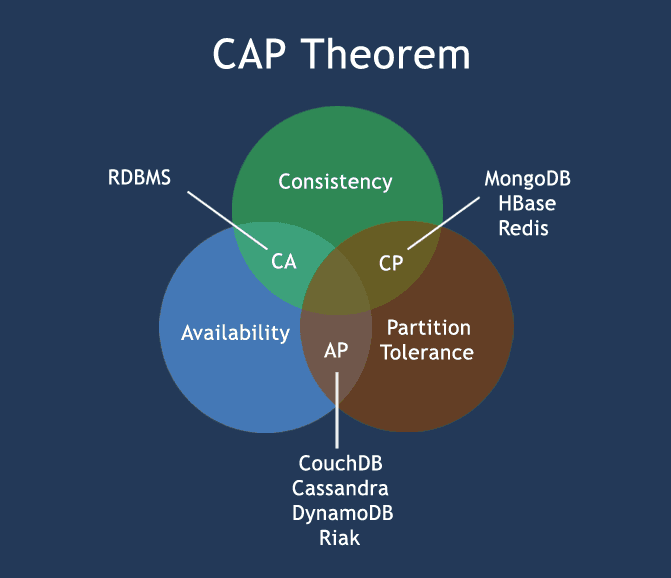RDBMS
- Structured and organized data
- Structured query language (SQL)
- Data and its relationships are stored in separate tables.
- Data Manipulation Language, Data Definition Language
- Tight Consistency
- BASE Transaction
- Structured and organized data
- Structured query language (SQL)
- Data and its relationships are stored in separate tables.
- Data Manipulation Language, Data Definition Language
- Tight Consistency
- BASE Transaction
NoSQL
- Stands for Not Only SQL
- No declarative query language
- No predefined schema
- Key-Value pair storage, Column Store, Document Store, Graph databases
- Eventual consistency rather ACID property
- Unstructured and unpredictable data
- CAP Theorem
- Prioritizes high performance, high availability and scalability
- Stands for Not Only SQL
- No declarative query language
- No predefined schema
- Key-Value pair storage, Column Store, Document Store, Graph databases
- Eventual consistency rather ACID property
- Unstructured and unpredictable data
- CAP Theorem
- Prioritizes high performance, high availability and scalability
Brief history of NoSQL
The term NoSQL was coined by Carlo Strozzi in the year 1998. He used this term to name his Open Source, Light Weight, DataBase which did not have an SQL interface.
In the early 2009, when last.fm wanted to organize an event on open-source distributed databases, Eric Evans, a Rackspace employee, reused the term to refer databases which are non-relational, distributed, and does not conform to atomicity, consistency, isolation, durability - four obvious features of traditional relational database systems.
In the same year, the "no:sql(east)" conference held in Atlanta, USA, NoSQL was discussed and debated a lot.
And then, discussion and practice of NoSQL got a momentum, and NoSQL saw an unprecedented growth.
CAP Theorem (Brewer’s Theorem)
You must understand the CAP theorem when you talk about NoSQL databases or in fact when designing any distributed system. CAP theorem states that there are three basic requirements which exist in a special relation when designing applications for a distributed architecture.
Consistency - This means that the data in the database remains consistent after the execution of an operation. For example after an update operation all clients see the same data.
Availability - This means that the system is always on (service guarantee availability), no downtime.
Partition Tolerance - This means that the system continues to function even the communication among the servers is unreliable, i.e. the servers may be partitioned into multiple groups that cannot communicate with one another.
In theoretically it is impossible to fulfill all 3 requirements. CAP provides the basic requirements for a distributed system to follow 2 of the 3 requirements. Therefore all the current NoSQL database follow the different combinations of the C, A, P from the CAP theorem. Here is the brief description of three combinations CA, CP, AP :
CA - Single site cluster, therefore all nodes are always in contact. When a partition occurs, the system blocks.
CP - Some data may not be accessible, but the rest is still consistent/accurate.
AP - System is still available under partitioning, but some of the data returned may be inaccurate.
CP - Some data may not be accessible, but the rest is still consistent/accurate.
AP - System is still available under partitioning, but some of the data returned may be inaccurate.

NoSQL pros/cons
Advantages :
- High scalability
- Distributed Computing
- Lower cost
- Schema flexibility, semi-structure data
- No complicated Relationships
Disadvantages
- No standardization
- Limited query capabilities (so far)
- Eventual consistent is not intuitive to program for
The BASE
he BASE acronym was defined by Eric Brewer, who is also known for formulating the CAP theorem.
The CAP theorem states that a distributed computer system cannot guarantee all of the following three properties at the same time:
- Consistency
- Availability
- Partition tolerance
A BASE system gives up on consistency.
- Basically Available indicates that the system does guarantee availability, in terms of the CAP theorem.
- Soft state indicates that the state of the system may change over time, even without input. This is because of the eventual consistency model.
- Eventual consistency indicates that the system will become consistent over time, given that the system doesn't receive input during that time.
ACID vs BASE
| ACID | BASE |
|---|---|
| Atomic | Basically Available |
| Consistency | Soft state |
| Isolation | Eventual consistency |
| Durable |
BigTable, Cassandra, SimpleDB
- See more at: http://www.w3resource.com/mongodb/nosql.php#sthash.lXcRhVwy.dpuf
No comments:
Post a Comment